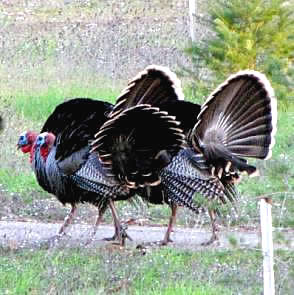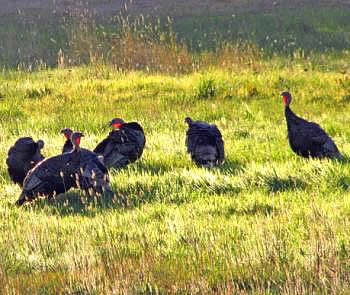 |
|
Columbus Day, Thanksgiving,
and the Children of Uganda
A talk given by Bhikshuni Heng Yin on December 9, 2011
I have heard more than once that people who come to visit CTTB feel that the people who live here are sometimes conservative and quick to pass judgment on others. I reflected on this, and maybe it’s because we strive to hold a high standard of moral behavior and precepts, following numerous unwritten rules, having tight schedules of group cultivation, and expecting everyone to conform to these when they first arrive.
When people come from afar, they might be delighted by the environment, or confused, or even turned off, depending on their background. If they are not from a traditional, Asian, and Buddhist upbringing, they might have a hard time. I remember that when I first came, I was just out of college and just a novice in Buddhism – I had probably been introduced to Buddhism a year earlier at my university, but did not practice it thoroughly enough such that everything was still totally new to me. Of course, I had heard a lot of Dharma and read a lot of the Master’s teachings, all of which brought me here to CTTB.
In the beginning, I had to get used to the custom of changing my shoes to go into the restroom, and also become comfortable with the belief that there are ghosts and spirits everywhere around us, watching us and taking accounts. This, I found both funny and scary, something that I could not quite swallow. However, because of the Dharma that I heard, which was what originally drew me here and which was crucial to the meaning and purpose of life, I was willing to accept the other parts provisionally and just let time pass before I decide what to do with them. Over the years, this place has grown to be home and to be a part of me. It has become very comfortable, maybe sometimes too comfortable that I can barely separate what used to be foreign to me as a newcomer from what makes sense to me now. This makes it hard for me to relate to the newcomers because I kind of swallowed some of those things whole without chewing.
Recently, I also noticed that when I pass judgment too quickly on a situation or on a person, things tend to get worse. It’s much better to wait, listen, and see how things develop. After all we know that self and reality are constructed and constantly changing things, a projection. Yet we, as ordinary people, tend to think that we are who we are, that we are a certain way and our reality is a common one. We think that because we know who we are, we can also judge who other people are. But, from a Buddhist perspective, we each live in our own world and nothing is definite. There are layers upon layers of falseness and distortion that we have to peel through. As a very superficial example of some of the distorted ideas and assumptions that we hold, which are also things that we learned in school, from our families, or from the media, I’d like to talk about a couple of the holidays we’ve just had – Columbus Day and Thanksgiving.
To start, let’s talk about Columbus Day. It is celebrated on the second Monday of October. It was signed into law as a national holiday in 1934 by President Franklin Roosevelt after being lobbied by the Knights of Columbus, a Catholic service organization. This organization, whose goal was to fight discrimination against Catholic immigrants, thought to use Columbus as a symbol of the Catholics’ right to citizenship since he was the “hero” who discovered America in 1492. Or rather, that’s what most people thought. First, the Native Americans had already been living here for over 14,000 years before he arrived. So, we couldn’t really say that he “discovered” the land. Other studies indicate that the Viking Leif Erickson was probably the first European to arrive in North America 500 years before Columbus.
Second, what I didn’t really know when I was in school, is that Columbus was hardly a hero. When he reached an island in the Bahamas, which he thought was India I presume, he was greeted by friendly and peaceful people called the Lucayans, Tainos, and Arawaks. He wrote in his diary that these people were very hospitable, that they would share anything with anyone and would never say no when asked of something. The Arawaks had no weapons; their society had no criminals, no prisons, and no prisoners. They were so kind that on the day that his ship, the Santa Maria, was shipwrecked, the Arawaks worked for hours to save his crew and cargo. They were so honest that not a thing was missing. Columbus, however, promptly seized their land for Spain and enslaved them to work in his brutal gold mines. Within two years, half of them, or 125,000, were dead.
Columbus also supervised a sex trade of native girls as young as 9 or 10. If the natives who worked in the gold mines did not deliver the required amount of gold, their hands would be cut off. Catholic law prohibited the enslaving of Christians, so Columbus decided not to baptize them. Many other atrocities were documented by one of Columbus' men, Bartolome De Las Casas, who was so ashamed of the brutality of the Spaniards under Columbus that he quit and became a Catholic priest to help the natives. He documented how the Spaniards cut off the noses and ears of men and the legs of children, and made bets as to whether they could cut a person in half with one sweep of the sword. In just one day, De Las Casas saw the Spanish soldiers dismember, behead, and rape 3000 people. He wrote, "Such inhumanities and barbarisms were committed in my sight as no age can parallel. My eyes have seen these acts so foreign to human nature that now I tremble as I write." Within 50 years, the original population of Hispaniola (Dominican Republic and Haiti) of three million natives had been decimated.
If Columbus stood out in any way, besides bringing America more fully to the consciousness of Europe as a place to colonize and exploit, it was for his atrocities and for being the first slave trader in the Americas. After he had used up all the natives as slaves, he started trading Africans.
On a different note, Thanksgiving is a day of gratitude. Traditionally, it’s said that the pilgrims who came to America wanted to give thanks to God for having survived an arduous journey and the cold winter because the Native Americans taught them how to plant and to fish so they wouldn’t starve. The first feast was held in 1621. If you ask an American, they’ll say Thanksgiving is the day you have a feast with turkey. It’s not even clear that turkey was served in that first feast in 1621. In fact, turkeys were not widely served on Thanksgiving until 1947. Because the National Turkey Federation decided they wanted to promote turkey consumption, they bred turkeys. Wild turkeys have dark meat, and they bred them until they were a nice white color and the feathers were easy to take off. So from 1947 onwards, the average turkey consumption went from 3 pounds per person per year in 1947 to 17.5 pounds per person per year today, which shows how successful the National Turkey Federation was. Not only that, in factory farmed turkeys now, they raised the weight of turkeys from their natural weight of 18 pounds, to 28 pounds. This means they’re growing so fat and heavy that they can no longer live naturally. In fact, they have problems with their feet and legs.
Wild turkeys, like those we see at CTTB, weigh from 8-18 pounds and can fly up to 55 miles an hour.

They have unique voices with 30 distinct vocalizations. They’re highly intelligent and emotional animals that show great affection to others. They have strong skills that allow them to recognize details on over one thousand acres of land so that they know where they are. Benjamin Franklin originally wanted the turkey to be the national bird, not the bald eagle. Unfortunately that didn’t happen, so the turkey’s fate is to be eaten a lot. More than 46 million turkeys are slaughtered for Thanksgiving dinners, often without being stunned out of consciousness.
I just wanted to show that the common understanding of Thanksgiving and turkey is actually manufactured out of commercial interests and not a historical thing. Of course, we don’t eat turkey here, so it’s just information to share with others. This is just a very shallow example of one of the top layers of distortion that we have about our world.
So to close on a somewhat more positive note…
Four years ago in 9 th grade Ethics class, students studied about child soldiers in Uganda and the genocide in Darfur. Their assignment was to come up with five ideas for themselves, the class, and the school, to improve the situation. Four of the students immediately formed a club. They went on to raise money and give speeches until they had enough money to sponsor a girl in Uganda to attend school. For the past three years, the school has been sponsoring two girls, Ritah in 5 th grade and Antonia in 7 th grade, through the Children of Uganda organization. This year, that organization is organizing a tour to the United States, bringing 20 Ugandan children to perform dance, music, and drumming. This is to raise awareness about the AIDS crisis and the plight of orphans and vulnerable children in Uganda and Africa. Uganda has 3.5 million orphans, the most of any country in the world. Over 50% of its population is under 15. There are so many children that it is their custom to call any girl older than they are “Mommy”.
This tour was coming to San Francisco and we contacted them, so they are coming to the City of Ten Thousand Buddhas in January to have a cultural exchange with our students. They are excited about visiting a Buddhist monastery, about learning Chinese, and eating vegetarian food. It will be a totally different world for them, and also a special opportunity for our students to meet them and know what life is like for these orphans.

